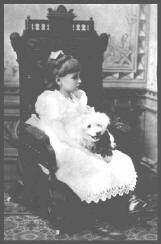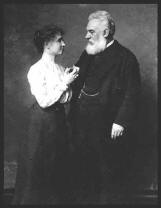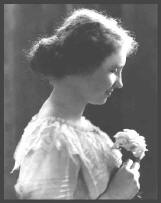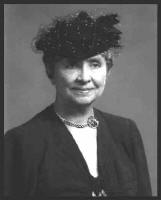|
Thatís right, Nathan
Hale, John Adams and John Quincy Adams could be found on her family
tree. On her fatherís side, she was descended from Alexander Spottswood,
a colonial governor of Virginia, and connected with the Lees and other
Southern families. She was a true Daughter of the Confederacy.
Her father was the
editor of a newspaper, had a strong interest in public life, and was an
influential figure in his own community. In 1885, under the Cleveland
administration, he was appointed Marshal of North Alabama.
Her mother, Kate Adams
Keller, was a tall, statuesque blond with blue eyes. She was some twenty
years younger than her husband, Captain Arthur Keller, a loyal
southerner who had proudly served in the Confederate Army during the
American Civil War.
Helen Adams Keller was
born in a small rural town in Northwest Alabama, Tuscumbia, on June 27,
1880, in a white, frame cottage called "Ivy Green." It was a simple,
white, clapboard house built in 1820 by Helen's grandparents. At the
time of Helen's birth, the family was not wealthy, with Captain Keller
earning a living as both a cotton plantation owner and the editor of a
weekly local newspaper, the "North Alabamian". Helen's mother, as well
as working on the plantation, would save money by making her own butter,
lard, bacon and ham.
Helen's life changed
drastically very early. In February 1882, when she wasnít even nineteen
months old, Helen fell ill. To this day the nature of her ailment
remains a mystery. The doctors of the time called it "brain fever",
whilst modern day doctors think it may have been scarlet fever or
meningitis. Popular belief had it that the disease left its victim an
idiot. And as Helen Keller grew from infancy into childhood, wild,
unruly, and with little real understanding of the world around her, this
belief was seemingly confirmed.
Whatever the illness and
whatever the name, Helen was, for many days, expected to die. When,
Eventually, however, the fever began to subside, and Helen's family grew
optimistic, believing their daughter to be well again. However, Helen's
mother soon noticed how her daughter was failing to respond when the
dinner bell was rang or when she passed her hand in front of her
daughter's eyes.
Soon, it became apparent
that Helen's illness had left her both blind and deaf.
The following few years
proved very hard for Helen and her family. Helen became a very difficult
child, smashing dishes and lamps and terrorizing the whole household
with her screaming and temper tantrums. Some of her relatives regarded
her as a monster and thought she should be put into an asylum.
 By
the time Helen was six her family had become desperate. Looking after
Helen was proving too much for them. Kate Keller had read in Charles
Dickens' book "American Notes" of the fantastic work that had been done
with another deaf and blind child, Laura Bridgman, and traveled to a
specialist doctor in Baltimore for advice. They were given confirmation
that Helen would never see or hear again but were told not to give up
hope, the doctor believed Helen could be taught and he advised them to
visit a local expert on the problems of deaf children. This expert was
Alexander Graham Bell, the inventor of the telephone; Bell was now
concentrating on what he considered his true vocation, the teaching of
deaf children. By
the time Helen was six her family had become desperate. Looking after
Helen was proving too much for them. Kate Keller had read in Charles
Dickens' book "American Notes" of the fantastic work that had been done
with another deaf and blind child, Laura Bridgman, and traveled to a
specialist doctor in Baltimore for advice. They were given confirmation
that Helen would never see or hear again but were told not to give up
hope, the doctor believed Helen could be taught and he advised them to
visit a local expert on the problems of deaf children. This expert was
Alexander Graham Bell, the inventor of the telephone; Bell was now
concentrating on what he considered his true vocation, the teaching of
deaf children.
Alexander Graham Bell
suggested that the Kellers write to Michael Anagnos, director of the
Perkins Institution and Massachusetts Asylum for the Blind, and request
that he try and find a teacher for Helen. Michael Anagnos considered
Helen's case and immediately recommended a former pupil of the
institution, that woman was Anne Sullivan.
Anne Sullivan had lost
the majority of her sight at the age of five. By the age of ten, her
mother had died and her father deserted her. She and her brother Jimmie
were sent to the poorhouse in February 1876.
Anne's brother died in
the poorhouse. It was October 1880 before Anne finally left and went to
commence her education at the Perkins Institution. One summer during her
time at the institute, Anne had two operations on her eyes, which led to
her regaining enough sight to be able to read normal print for short
periods of time.
Anne graduated from
Perkins in 1886 and began to search for work. Finding work was terribly
difficult for Anne, due to her poor eyesight, and when she received the
offer from Michael Anagnos to work as the teacher of Helen Keller, a
deaf-blind mute, although she had no experience in this area, she
accepted willingly.
On March 3, 1887, Anne
arrived at the house in Tuscumbia and for the first time met Helen
Keller. Anne immediately started teaching Helen to finger spell.
Spelling out the word "Doll" to signify a present she had brought with
her for Helen. The next word she taught Helen was "Cake". Although Helen
could repeat these finger movements she could not quite understand what
they meant. And while Anne was struggling trying to help her understand,
she was also struggling to try and control Helen's continuing bad
behaviour.
Anne and Helen moved
into a small cottage on the land of the main house to try and get Helen
to improve her behaviour. Of particular concern were Helen's table
manners. She had taken to eating with her hands and from the plates of
everyone at the table.
Anne's attempts to
improve Helen's table manners and make her brush her own hair and button
her shoes led to more and more temper tantrums. Anne punished these
tantrums by refusing to "talk" with Helen by spelling words on her
hands.
Over the coming weeks,
however, Helen's behaviour did begin to improve as a bond grew between
the two. Then, after a month of Anne's teaching, what the people of the
time called a "miracle" occurred. Helen had until now not yet fully
understood the meaning of words. When Anne led her to the water pump on
April 5, 1887, all that was about to change.
As Anne pumped the water
over Helen's hand, Anne spelled out the word water in the girl's free
hand. Something about this explained the meaning of words within Helen,
and Anne could immediately see in her face that she finally understood.
Helen later recounted
the incident: "We walked down the path to the well-house, attracted by
the fragrance of the honey-suckle with which it was covered. Someone was
drawing water and my teacher placed my hand under the spout. As the cool
stream gushed over one hand she spelled into the other the word water,
first slowly, then rapidly. I stood still, my whole attention fixed upon
the motions of her fingers. Suddenly I felt a misty consciousness as of
something forgotten, a thrill of returning thought, and somehow the
mystery of language was revealed to me."
Helen immediately asked
Anne for the name of the pump to be spelt on her hand and then the name
of the trellis. All the way back to the house Helen learned the name of
everything she touched and also asked for Anne's name. Anne spelled the
name "Teacher" on Helen's hand. Within the next few hours Helen learnt
the spelling of thirty new words.
Helen's progress from
then on was astonishing. Her ability to learn was far in advance of
anything that anybody had seen before in someone without sight or
hearing. It wasn't long before Anne was teaching Helen to read, firstly
with raised letters and later with Braille, and to write with both
ordinary and Braille typewriters.
Michael Anagnos was keen
to promote Helen; one of the numerous articles on her that he wrote said
of Helen "she is a phenomenon". These articles led to a wave of
publicity about Helen with pictures of her reading Shakespeare or
stroking her dog appearing in national newspapers.
 Helen
had become famous, and as well as again visiting Alexander Graham
Bell, she visited President Cleveland at the White House. Helen
had become famous, and as well as again visiting Alexander Graham
Bell, she visited President Cleveland at the White House.
|
By 1890 she was living
at the Perkins Institute and being taught by Anne. In March of that year
Helen met Mary Swift Lamson who over the coming year was to try and
teach Helen to speak. This was something that Helen desperately wanted
and although she learned to understand what somebody else was saying by
touching their lips and throat, her efforts to speak herself proved at
this stage to be unsuccessful. This was later attributed to the fact
that Helen's vocal chords were not properly trained prior to her being
taught to speak.
On 4 November 1891 Helen
sent Michael Anagnos a birthday gift of a short story she had written
called "The Frost King". Anagnos was so delighted with the story that he
had soon published it in a magazine hailing its importance in literary
history. However, it was soon discovered that Helen's story was the same
as one called "The Frost Fairies" by Margaret Canby. This was ultimately
to be the end of Helen and Anne's friendship with Michael Anagnos. He
felt he had been made to appear foolish by what he considered to be
Helen's deception.
There had to be an
investigation and it was discovered that Helen had previously been read
the story some years before and had obviously remembered it. Helen
always claimed not to recall the original story and it should always be
remembered that Helen was still only 11 years old, however, this
incident created a rift that would never heal between Helen, Anne and
Anagnos. It also created great doubt in Helen's own mind as to whether
any of her thoughts were truly her own.
 In
1894 Helen and Anne met John D Wright and Dr Thomas Humason who were
planning to set up a school to teach speech to the deaf in New York
City. Helen and Anne were very excited by this and the assurances of the
two men that Helen's speech could be improved excited them further.
Helen thus agreed to attend the Wright-Humason School for the Deaf.
Unfortunately though, Helen's speech never really improved beyond the
sounds that only Anne and others very close to her could understand. In
1894 Helen and Anne met John D Wright and Dr Thomas Humason who were
planning to set up a school to teach speech to the deaf in New York
City. Helen and Anne were very excited by this and the assurances of the
two men that Helen's speech could be improved excited them further.
Helen thus agreed to attend the Wright-Humason School for the Deaf.
Unfortunately though, Helen's speech never really improved beyond the
sounds that only Anne and others very close to her could understand.
Helen moved on to the
Cambridge School for Young Ladies in 1896 and in the autumn of 1900
entered Radcliff College, becoming the first deaf and blind person to
have ever enrolled at an institution of higher learning. Life at
Radcliff was very difficult for Helen and Anne, and the huge amount of
work involved led to deterioration in Anne's eyesight. During their time
at the College Helen began to write about her life. She would write the
story both in Braille and on a normal typewriter. It was at this time
that Helen and Anne met with John Albert Macy who was to help edit
Helen's first book "The Story of My Life" which was published in 1903
and although it sold poorly at first it has since become a classic.
 On
28 June 1904 Helen graduated from Radcliff College, becoming the first
deaf and blind person to earn a Bachelor of Arts degree. On
28 June 1904 Helen graduated from Radcliff College, becoming the first
deaf and blind person to earn a Bachelor of Arts degree.
John Macy became good
friends with Helen and Anne, and in May 1905 John and Anne were married.
Anne's name now changed to Anne Sullivan Macy. The three lived together
in Wrentham, Massachusetts, and during this time Helen wrote "The World
I Live In", revealing for the first time her thoughts on her world. It
was also during this time that John Macy introduced her to a new and
revolutionary way of viewing the world. And in 1909 Helen became a
member of the Socialist Party of Massachusetts.
In 1913 "Out of the
Dark" was published. This was a series of essays on socialism and its
impact on Helen's public image was immense. Everyone now knew Helen's
political views.
Helen and Anne filled
the following years with lecture tours, speaking of her experiences and
beliefs to enthralled crowds. Her talks were interpreted sentence by
sentence by Anne Sullivan, and were followed by question and answer
sessions.
Helen's mother Kate died
in 1921 from an unknown illness, and this left Anne as the sole constant
in Helen's life. However that same year Anne fell ill again and this was
followed in 1922 by a severe bout of bronchitis which left her unable to
speak above a whisper and thus unable to work with Helen on stage
anymore. At this point Polly Thomson, who had started working for Helen
and Anne in 1914 as a secretary, took on the role of explaining Helen to
the theatre going public.
They also spent a lot of
time touring the world raising money for blind people. In 1931 they met
King George and Queen Mary at Buckingham Palace, who were said to be
deeply impressed by Helen's ability to understand what people said
through touch.
All the while Anne's
health was getting worse, and with the news of the death of John Macy in
1932, although their marriage had broken up some years before, her
spirit was finally broken. She died on 20 October 1936. When Anne died,
Helen and Polly moved to Arcan Ridge, in Westport, Connecticut, which
would be Helen's home for the rest of her life.
After World War Two,
Helen and Polly spent years traveling the world fundraising for the
American Foundation for the Overseas Blind. They visited Japan,
Australia, South America, Europe and Africa.
Whilst away during this
time Helen and Polly learnt of the fire that destroyed their home at
Arcan Ridge. Although the house would be rebuilt, as well as the many
mementoes that Helen and Polly lost, also destroyed was the latest book
that Helen had been working on about Anne Sullivan, called "Teacher".
It was also during this
time that Polly Thomson's health began to deteriorate and whilst in
Japan she had a mild stroke. Doctors advised Polly to stop the
continuous touring she and Helen did, and although initially they slowed
down a bit, the touring continued once Polly had recovered.
 In
1953 a documentary film "The Unconquered" was made about Helen's life,
this was to win an Academy Award as the best feature length documentary
.It was at the same time that Helen began work again on her book
"Teacher", some seven years after the original had been destroyed. The
book was finally published in 1955. In
1953 a documentary film "The Unconquered" was made about Helen's life,
this was to win an Academy Award as the best feature length documentary
.It was at the same time that Helen began work again on her book
"Teacher", some seven years after the original had been destroyed. The
book was finally published in 1955.
Polly Thomson had a
stroke in 1957. She was never to fully recover and died on March 21,
1960. Her ashes were deposited at the National Cathedral in Washington
DC next to those of Anne Sullivan. It was the nurse who had been brought
in to care for Polly in her last years, Winnie Corbally, who was to take
care of Helen in her remaining years.
The script
of The Miracle Worker was sent in Braille to Miss Keller
just before she spoke to the International Convention of Rotary
International in Lucerne, Switzerland.
It was in 1957 that "The
Miracle Worker" was first performed. A drama portraying Anne Sullivan's
first success in communicating with Helen as a child, it first appeared
as a live television play in the United States.
In 1959 it was
re-written as a Broadway play and opened to rave reviews. It became a
smash hit and ran for almost two years. In 1962 it was made into a film
and the actresses playing Anne and Helen both received Oscars for their
performances
After
re-writes, The Miracle Worker opened on Broadway at the Playhouse
Theatre on October 19, 1959, starring Anne Bancroft as teacher, Annie
Sullivan, Patricia Neal as Helen's mother, Kate Keller, and Patty Duke
as Helen Keller, the blind-deaf child. The show became one of the most
electrifying theatrical events of the 1959-1960 season. It went on to
win six Tony Awards, including best play.
Doug Rudman
Sources included
The Rotarian; Dorothy Herrmannís Helen Keller A Life;
Margaret Davidsonís Helen Keller's Teacher; The
Three Lives of Helen Keller, by Richard Harrity and Ralph G.
Martin; and Nigel Hunterís Helen Keller.
All photos:
American Foundation for the Blind |





